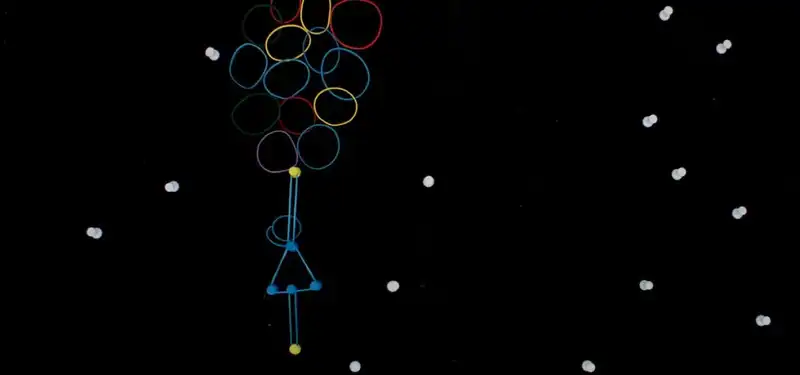Nov 28, 2017
It's not just a rubber band, it's an animated character.
In a world where perfection and brilliance have become so easily accessible that uniqueness and imperfection are increasingly valued, through three animated shorts, Cartoon Brew explores the storytelling power of real material.
Cartoon Brew, along with the directors of each film (via phone and Skype interviews), analyzed the mechanics of the witty "A Girl Named Elastica," the emotional "Women's Letters," and the irresistibly cute yet cruel "Bubble Wrap Fantaisie" The mechanism was analyzed. Pushpins, papier-mâché, and petite ...... These materials were integral to the storytelling of these films.
In Guillaume Blanchet's A Girl Named Elastica, the protagonist, Elastica, is depicted using only pushpins. She travels through cities, pyramids, and oceans. A fantastical world created only with rubber bands, pushpins, paper clips, corks, and paper. Elastica sometimes takes the form of a more or less recognizable character through a crowd of pushpins, but more often she is distant and basically just a dot.
"With this film, I challenged the audience to become emotionally invested in something small and tiny," Blanchet explains. 'I'm very happy that the audience can relate to her, either as a character or as a representative of girl power.' When the audience begins to think of a stud as a person, to feel fear, joy, or excitement about a stud, then I have succeeded."
[8Throughout the film, Blanchet incorporates many close-ups and visual sacrifices to continue to remind the audience of the realism of the material." Blanchet admits that "the raw color of cork is not very visually appealing. Being true to the actual material meant no post-production at all, turning animation into a time-consuming process. Unfortunately, some online viewers failed to appreciate the effort, commenting, "Do your job," or "Make her." But Blanchet smiles in retrospect: "These people only see the work, not the imagination."
Ingenious inventions often emerged within the constraints set by the directors themselves. For example, the balloons at the end of the film are actually just a bunch of rubber bands. Despite or because of this simplicity, it became one of the most fantastic and visually sublime shots. The director recalls, "A number of people told me, 'This is so simple, I can come up with it myself.' The director recalls. I love that Elastica is an idea that anyone can have and make."
"Women's Letters" is a poignant 11-minute short made of papier-mâché. It depicts a World War I soldier delivering letters from her family to her comrades. Both the soldier and the letter are made of paper, both physically and psychologically. The film's metaphor is both painful and beautiful.
The ideas for the story and format of Women's Letters were conceived separately, but director Augusto Zanovero could not see them after the combination connected in his mind. The metaphor is a bit obvious," the director says. Paper is fragile. It can be burned, it can be cut, it can have memories written on it. To me, people are like paper."
The soldiers in Womens' Letters embody this paradox.
The papier-mâché technique also lends a certain softness to the harsh narrative. Says Zanovero, "War is a painful subject, and in a realistic style it quickly becomes shocking." 'With this film, I wanted to take the story to another dimension--a dimension gentler than reality.'
The director embraced any imperfections associated with the difficult-to-manipulate material. He frequently zooms in on the soldiers' crumpled paper faces to emphasize emotional moments. He said, "I like visual imperfections. Much like papier-mâché, life is not very constructed. Imperfection, that's what we are. It is what makes us human."
One look at Arthur Metcalf's Fantaisie in Bubblewrap will make you feel guilty about bursting plastic bubbles. Says Metcalf, "A producer friend of mine used to do that all the time." But she would put a face on each one first, instead of simply popping them. I thought it was a great idea and asked her if we could use it in the film."
The film's low quality cinematography is, in the director's own words, "shitty," but perhaps this imperfection is what makes it so humorous. For Metcalf, the film was not a conscious choice. "We had really limited technology at the time, so we came to this technique out of necessity, and it never occurred to me to animate it with CG or shoot it with a better camera. But I don't think anyone cares about quality as long as there are great jokes. Just look at 'South Park.
Regarding the film's success, Metcalf believes that people are enjoying the film because basically everyone is guilty of cracking the puchi puchi: in the Youtube comments section, the general sentiment is that "I'll never look at puchi puchi the same way again." It seems. Such is the perception. In that sense, I think the actual material, as opposed to drawn or computer-generated representations, ultimately helps the connection. People cry over a baby wrapped in a petite piece of paper. That makes me happy."
This article was inspired by the thematic program "Things Have Feelings Too" presented at the 2015 KLIK Amsterdam Animation Festival.
.



Post your comment